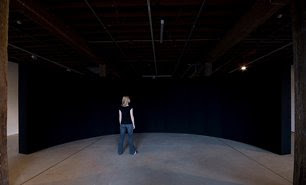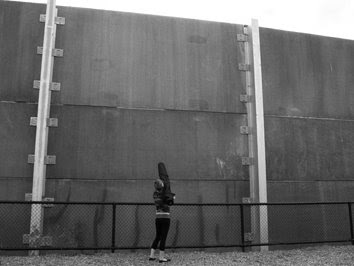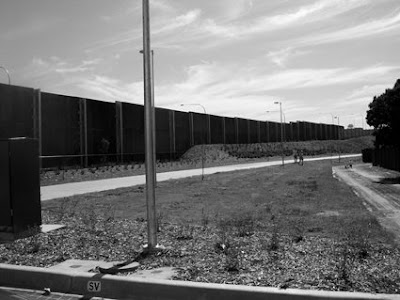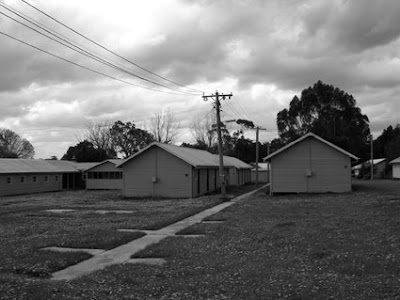After kicking off the 2008 exhibition year at Artspace, Lily Hibberd‘s Bordertown installation recently opened at Melbourne’s Conical Inc where it will be on show until March 29. The Art Life spoke with Hibberd in Melbourne.

Lily Hibberd, Bordertown, 2008.
Installation view.
TAL: What does the Bordertown installation look like? What are its components?
Lily Hibberd: Bordertown is a sound installation, sculptural wall and an A3 portfolio book. The wall spans 7 metres with a height of 3 metres. It’s in the shape of horseshoe or half-Pantheon, with black fabric entirely covering its structure. Its convex side faces the viewer on entry, drawing the audience around the object and creating a kind of amphitheatre within the room. Ten speakers are spaced across the inside and outside of the wall, five per side each in a surround-sound environment. On either side of the wall the voices of two women tell the story of Bordertown, a community that straddles two Australian states and a place renowned for historic conflicts. One woman has been dispatched as migrant labour to an internment camp on the outskirts town of; the other is an angry and disenfranchised young woman from the poorest part of Bordertown. The structure of the wall literally divides the characters, swapping between the two women’s stories from one side to the other. This sound component is 1 hour and 16 minutes long but is made up of short monologues and soundscapes that invite you to follow them around the wall.
TAL: And there is a book too?
LH: The book is situated in the entrance. It has three parts. In the middle section are 40 documentary photographs of Bordertown and a number of immigrant detention centres or migrant camps, as well as various relevant local historical sites. The back of the book contains the script for the two voiceovers, which are presented as transcripts of an interview with each woman. The first and main part of the publication is an extended diary of a woman who has resided for seven weeks in Bordertown, which functions as a contextual essay for the story.

TAL: How did you research Bordertown for the stories?
LH: From the outset I knew that I wanted to write about two women in a divided town and to construct this in the form of a dual narrative. The stories are in fact compilations of hundreds of snippets of conversations, collected texts, personal memories and recorded histories from many different times and places. The outline for the main character Stacey evolved over two years. I made a lot of storyboards in early 2007 and spent a month in Berlin writing some straight narratives that were consistently unsatisfactory because the work lacked any definitive structure. I only started defining the format of the show in August 2007 and at that point I quickly realised that I needed a specific location to base my research on. Through a series of connections I ended up in Albury, where I spent several months interviewing residents, meeting with refugee workers and a local historian. Albury-Wodonga proved to be an incredible location as a historically divided community that continues to suffer social partition and conflict between inhabitants of the two towns and the location of Bonegilla, the largest of many migrant camps established in rural centres after the Second World War. But while this research was based on a singular location, Bordertown is deliberately fictionalised, avoiding a fixed reading of the content. It could be any number of towns dotted along old colonial borders, or towns divided by other circumstances or historical conflicts.
TAL: Documentary sources are very often left by artists to speak as ‘authentic voices’ yet you’ve chosen to create fictionalised voices instead. How do you feel about creating characters in this and other works?
LH: The idea that any representation can exist as an unadulterated record is a fallacy. Yet contemporary art is rife with documentary style approaches. Essentially it doesn’t matter which category they fall into for a lot of these are thoroughly engaging as works in any form. Stories are the substance of history, so while the idea of adulterating history is distasteful, fiction cannot be avoided in recounting events. In Plato’s Republic the notion of artistic representation is embraced, termed as poesis. Yes it is mimetic, yes it’s seductive, and yes (as Socrates warned) it is dangerously deceptive, yet creative representation has a powerful role in the lives of individuals and can be very influential in the political transformation of a community. Only the dilemma remains that everybody wants to know if the story is true or not (personally I prefer a bit of mystery around this). Unfortunately the contemporary artist’s answer can be very convoluted and often cynical, even if rooted in an ideology of change. This is a habit that stems from Post-structuralist thought, which dismantled the authorial historical voice – albeit for many good reasons. On the basis that absolute ‘truths’ or facts about the world and the notion of a centralised “self” as a singular entity should be rejected. This dispute has not yet been abandoned by art. Ever since Roland Barthes penned The Death of the Author in 1968, the problem for artists has been how to make a work that is not an authored representation or at the very least demonstrates that it is aware of the problem. But if he had wanted us to take it literally, Barthes would have stopped writing. Yet for contemporary artists this has been the reason for elaborate ploys that allow them to continue to formulate art (short for artifice), whether in the iconoclasm of formal abstraction or the cutting satire of Post-modern appropriation. The dilemma of representation in art is a complex affair. For Bordertown I initially planned to construct the sound from a series of interviews. Except this seemed more problematic than creating a total fiction because the documentary mode would directly co-opt the lives of the interviewees, whose private interests were at stake. After a period of feeling the weight of moral obligations under this regime of representation I decided that I had revelled in the freedom of fiction in far too many wonderful films and books to be bound up in this debate. Nobody would fork out $15 for a movie ticket and then spend another second wondering why Daniel Day-Lewis was acting instead of playing himself in his latest epic drama.

TAL: In the past your work – painting and video – has investigated the nature of narrative through cinematic imagery and the snapshot. How did that interest lead you to the installation of Bordertown?
LH: That’s difficult to summarise. There are distinct motivations for each of my prior exhibitions apart from narrative or cinematic form as such…. I’d argue that the recent work is more theatrical, or even architectural, and that Bordertown is a piece that hinges on narrative as a form mainly because of the prevalence of the story. While the pictorial is less obvious, images are no less important in the work; the visual content is just positioned differently. Images abound, as pure description in the journal and narrations and in the photo essays. Still, I’d have to say that its impetus came directly out of a commitment to writing as an art form. Narrative plays out in the current work though the spatialisation of the sound, which requires viewers to “perform” the piece by walking around the horseshoe wall following the voices. I’m really fascinated by the possibilities for unusual engagement with narrative (another manipulation of the viewing experience was explored in the timed lighting used in Blinded by the Light). But I have to admit that you’re onto something because the most exciting part of making Bordertown was the process of scripting a sound piece in which whole scenes could be conceived and this part of the work ended up being utterly cinematic.
TAL: What do actors bring to the script and the work overall? Was “theatricality” something you considered in the overall piece?
LH: Once I’d decided to work across documentary and fiction there was no way I could ask the original interviewees to perform the script (although it did cross my mind). I also discovered that using actors would allow the stories to speak for themselves. In the end the characters in Bordertown are not disconnected from reality or factual material at all; they are a medium of communication for a whole collection of true stories. For me, the three voice-over artists bring the script to life. I’ve been hearing the sound track for a few weeks while installing and their characterisations still generate new versions of the material every time I listen to them. The format reminds more of a radio play than anything else. The performances have a theatrically but this is more consistent with the nature of the installation and the staginess of the arc than the way the actors executed their lines. However, I did not force “theatricality” onto the work, it just appeared as a necessary ingredient. Artists often say that their work tells them what to do and this is an important conversation in my relationship to art making, and so the elements present in Bordertown were developed quite organically rather than consciously in response to the material and ideas being generated by the work. I should add to this that it’s not as simple as the theatricality of the stage set, having curtains in the space, or actors. There are lots of different kinds of theatricality. There’s the conceptualised kind that Michael Fried decried in his maligned essay Art and Objecthood of 1967, in which he claims that the nature of Minimal Art is theatrical and that theatre is hostile to art. Then there’s the Brechtian transgressive kind, or Antonin Artaud’s Theatre of Cruelty. All of these approaches to creative form are fascinating to me, and not alien to art.
TAL: Is there an expectation that you are a “painter”? How do you conceptualise your practice in relation to the common threads that bind these projects together?
LH: I’ve always worked with lots of different mediums, painting being the predominant means of making images. Yet the expectation you mention depends on whether people have seen any of the work installed, as it’s hard to appreciate some of the complexity of these arrangements without seeing the actual exhibition. Blinded by the Light (2003), for instance, featured sequenced theatre lighting and a sound element, and Burning Memory (2001) included a documentary video that provided a historical context for the paintings (rather similar to the book in Bordertown). It is true that up until recently I was more concerned to work with painting, yet in 2006 I began to make much bolder statements in other media, such as the introduction of a script in the painting and performance work The Perfect Future Game, followed by the photography and sound installation, Endless Summer in 2007. I’m not worried about having threads or consistencies in my practice as I am far too obsessed with what each project requires on its own terms to be a great work. Yet a few consistent approaches that relate to narrative recur frequently through all the work I have made and are highlighted in Bordertown, like the tendency to create sequential works in arrangements that surround the viewer. I’ve also become increasingly devoted to the characters in my work since returning to figuration in Blinded by the Light. These people are not figments but are the compilation of innumerable encounters with others. I’m still in love with the man in Endless Summer. Stacey is also someone I feel very strongly about, even though she is difficult.
TAL: Your recent work in video and installations like Bordertown have blurred the lines between genres. Is that a comfortable place to be?
LH: Yes. I am very interested in working across genres. I’ve been doing it for quite some time, as I mentioned earlier. It’s important to me because it disrupts the presumptions of an easy reading of the work. When I introduce more than one approach into a piece it is not there as an embellishment but rather as an intervention (not that one can subvert one’s own art), which tends to dissect the content, or ask the viewer to question the representation before them. I guess this is a deliberate and playful effort to make things less comfortable without being aberrant. Some of the stuff I do has no good explanation or resolution to its elements, and I do get awkward when asked why this is so. I don’t always know, art practice an experiment. I’m discovering new things each time.

TAL: The book that you’ve written is long, around 40,000 words. How did you find the process of writing such a lengthy piece?
LH: My experience of writing the book was very intense because it was executed within six weeks. This occurred inadvertently as my intention was to compose a short introduction to the book, which ended up being the 27,000-word contextual journal piece. I had collected a massive amount of material on the project and once I started to recount the stories and comment on the details the essay rapidly became a thesis of 36,000 words. I think the long hours at the desk had a big impact on the kind of writing I produced as the story is extremely focused. I thought about little else for two months, apart from Christmas dinner. The struggle I faced was in editing the material down and rewriting the piece as a fictional diary. The script at the back of the book is another 8,000 words but was much more difficult to construct. The characters needed a lot of research and rewriting so that they could carry the story in a compelling way, and that had to be written prior to the diary so that the voiceovers and surround sound work could be recorded.
TAL: People often don’t think much about internal borders in Australia – its assumed within the non-Indigenous community that states, suburbs or streets are more or less interchangeable, administrative regions. What was your experience of Albury/Wodonga?
LH: I am not so concerned to highlight Albury-Wodonga as to illustrate the barriers that segregate countless Australian communities. In early 2007 I was assisting the artist Lyndal Jones with her project in the Central Victorian town of Avoca and found that place equally instructive for the way that historical divisions continued to be upheld. Although other locations apart from Albury-Wodonga (with its explicit State divide at the Murray River) might have less obvious physical signs of contestation. I would argue that the segregation of space is widespread in this country. Its practice is reiterated in daily performances of territorial demarcation on main streets, in suburban shopping centres and on our beaches (especially on Australia Day). Yet the purpose of studying one town very closely is to raise awareness of the way that historical events are inscribed in the psyche of a community and that as much as individuals may disregard that past that they are unavoidably caught up in a social structure which has been built up in the aftermath of those past events. My hope is that the two women in Bordertown demonstrate the power and magnitude of historical consciousness in the process of liberation and change.
TAL: What’s been the reception of Bordertown by people visiting the gallery?
LH: Sound can be quite a challenge to art audiences, so I have not been expecting a lot of in-depth comments. Responses have varied from being instantly stumped by the austerity of the wall, with someone claiming that they couldn’t “see” a work of art. I’ve been surprised by the curiosity of others who have wanted to converse at length on the form of the wall, the effect of the surround sound, the politics offered up in the book and the construction of the characters. These discussions have been a bit like Margaret and David talking about a film, I guess because there are so many aspects to the work and it is such a long piece requiring an investment of time on the part of viewers. I used to worry that I was making “difficult” or inaccessible art, but now I have realised that if people want to engage they will do it of their own volition. I’m just concerned that the content be communicated at some point.
Images of Bordertown and a PDF of the book can be found at www.lilyhibberd.com
